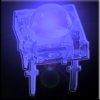Just started messing with these, and a little disappointed so far, maybe doing something wrong. They do appear brighter at 60 mA than similar 5mm LEDs that I usually use. But not really a big enough difference to justify the higher current, not to mention I have to do PCB artwork in CorelDraw, do to the package and my electronics program doesn't allow me to make parts.
I mount 6 on stripboard, and replaced the 5mms on my fader circuit, got some strange results. The two reds work as expected. Two blues fade in to a point, then sudden full ON bright, fade out very fast. The green similar to the blue. Tried various limiting resistors, same results. Went back to the old 5mms, circuit works, but not the same. Thinking I damaged the LM324s, have to try and replace them.
Also made a growlight (red/blue LEDs), the blue are much brighter then the red, where the 5mms were the other way around.
Now, these are cheap (why I bought them) chinese knockoffs, so there could be some or all defectives. Only burned up one, but was a little rough with soldering iron, oops...
Just wonder what everybody else is experiencing with these LEDs. They were priced about the same as regular LEDs, so too a shot. In practice, seem more trouble then they are worth (probably why they were going so cheap)...
I mount 6 on stripboard, and replaced the 5mms on my fader circuit, got some strange results. The two reds work as expected. Two blues fade in to a point, then sudden full ON bright, fade out very fast. The green similar to the blue. Tried various limiting resistors, same results. Went back to the old 5mms, circuit works, but not the same. Thinking I damaged the LM324s, have to try and replace them.
Also made a growlight (red/blue LEDs), the blue are much brighter then the red, where the 5mms were the other way around.
Now, these are cheap (why I bought them) chinese knockoffs, so there could be some or all defectives. Only burned up one, but was a little rough with soldering iron, oops...
Just wonder what everybody else is experiencing with these LEDs. They were priced about the same as regular LEDs, so too a shot. In practice, seem more trouble then they are worth (probably why they were going so cheap)...



